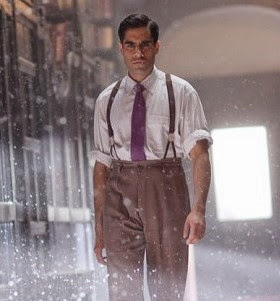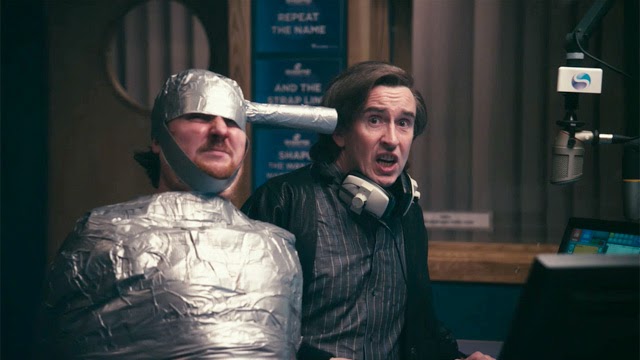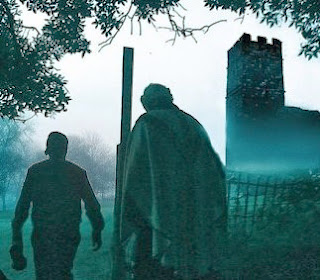A GHOST STORY FOR CHRISTMAS - THE TRACTATE MIDDOTH (2013)
M.R. JAMES: GHOST WRITER (2013)
CROOKED HOUSE stands as a fine companion to the BBC's celebrated GHOST STORY strand of the 1970s.
AIRED over three consecutive evenings on BBC4 in the lead-up to Christmas 2008, CROOKED HOUSE - written and produced by Mark Gatiss - merges the gravitas of M.R. James with the playfulness of the Amicus portmanteau. The three stories concern Geap Manor - a house with "an interesting reputation" - enveloped by a framing story which sees a museum curator (Gatiss) share his research of the Tudor mansion with history teacher Ben (Lee Ingleby), who has brought in an old door-knocker found in his garden. The first tale, The Wainscoting, sees Joseph Bloxham (Philip Jackson) renovating Geap in 1786 after capitalising on an investment which ruined a fellow speculator. As the building work comes to an end Bloxham hears noises behind the interior wooden panels, which have been sourced from gallows. The second story, Something Old, is set amongst a lavish 1920s costume ball at the Manor, where Felix (Ian Hallard) announces his engagement to underling Ruth (Jennifer Hignam). However, this happy event is linked to a tragic wedding day and a ghostly bride. And in the modern day final part, The Knocker, Ben discovers that his property is set in the grounds of the demolished Manor, which sees sinister figures from the past pray upon his new born child.
Director Damon Thomas works wonders with a limited budget, and the cast includes individuals in roles they are relishing, such as Andy Nyman (The Wainscoting), Jean Marsh (Something Old) and even illusionist Derren Brown (The Knocker). Geap is portrayed as a constant threat whatever its condition (the house "drew evil to it like a sponge draws in water") and situations are infused with wry humour (the builders ever-expanding schedule, Ruth's family background "in fish.") While the first two tales are entertainingly creepy, the show saves the scariest till last, containing not only a masterful twist but a swath of 1970s-tinted nastiness. It is, however, the abomination - played by 7'3" John Lebar - conjured out of an Elizabethan crib, that will leave you scurrying for safety.
 The elemental menace of THE TRACTATE MIDDOTH is stylishly photographed by Steve Lawes.
The elemental menace of THE TRACTATE MIDDOTH is stylishly photographed by Steve Lawes.
Gatiss penned - and made his directorial debut - with THE TRACTATE MIDDOTH, a faithful adaptation of James' story first published in the 1911 collection More Ghost Stories. Young librarian Garnett (Sacha Dhawan) has a vision of a skull-entity while searching for an old tome for John Eldred (John Castle). Garnett takes leave in the country where he meets Mrs Simpson (Louise Jameson) and her daughter Anne (Charlie Clemmow), who tell him of a missing will that would make them heir to a sizeable inheritance. Unfortunately the document has been written in an obscure book, linking the librarian to late priest Dr Rant (David Ryall): "twisted, he was, twisted, while others had a soul, he had a corkscrew; don't trust him in life or death." On the written page the first appearance of "the figure" is a "perfectly dry" upper face with deep-sunk eyes covered in cobwebs; the prosthetics on screen are in accord with this crusty visage, and the climax - the second "monster of the week" moment - is effectively carried out in broad daylight.
THE TRACTATE MIDDOTH on BBC2 Christmas Day 2013 was followed by Gatiss' M.R. JAMES: GHOST WRITER. What is most striking about this documentary is how secondary in his life the ghost stories James wrote were; they were almost a hobby, a pursuit after his astonishing achievements as a medieval scholar. Gatiss paints a picture of a sexually repressed man who also viewed his tales as a social device, particularly for readings at King's College's Chitchat Society (where James enjoyed sessions of "ragging," essentially floor-bound genital-grabbing). It is a compelling piece, where we follow James' journey from happy childhood - fascinated with the historical and the supernatural - to his studies, his infatuation with James McBryde, and increasing disillusionment with The Great War.
 The elemental menace of THE TRACTATE MIDDOTH is stylishly photographed by Steve Lawes.
The elemental menace of THE TRACTATE MIDDOTH is stylishly photographed by Steve Lawes.Gatiss penned - and made his directorial debut - with THE TRACTATE MIDDOTH, a faithful adaptation of James' story first published in the 1911 collection More Ghost Stories. Young librarian Garnett (Sacha Dhawan) has a vision of a skull-entity while searching for an old tome for John Eldred (John Castle). Garnett takes leave in the country where he meets Mrs Simpson (Louise Jameson) and her daughter Anne (Charlie Clemmow), who tell him of a missing will that would make them heir to a sizeable inheritance. Unfortunately the document has been written in an obscure book, linking the librarian to late priest Dr Rant (David Ryall): "twisted, he was, twisted, while others had a soul, he had a corkscrew; don't trust him in life or death." On the written page the first appearance of "the figure" is a "perfectly dry" upper face with deep-sunk eyes covered in cobwebs; the prosthetics on screen are in accord with this crusty visage, and the climax - the second "monster of the week" moment - is effectively carried out in broad daylight.
THE TRACTATE MIDDOTH on BBC2 Christmas Day 2013 was followed by Gatiss' M.R. JAMES: GHOST WRITER. What is most striking about this documentary is how secondary in his life the ghost stories James wrote were; they were almost a hobby, a pursuit after his astonishing achievements as a medieval scholar. Gatiss paints a picture of a sexually repressed man who also viewed his tales as a social device, particularly for readings at King's College's Chitchat Society (where James enjoyed sessions of "ragging," essentially floor-bound genital-grabbing). It is a compelling piece, where we follow James' journey from happy childhood - fascinated with the historical and the supernatural - to his studies, his infatuation with James McBryde, and increasing disillusionment with The Great War.






























